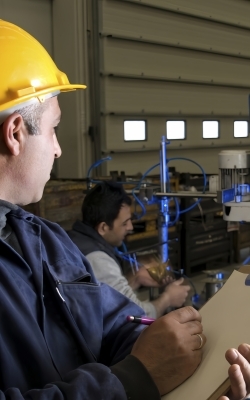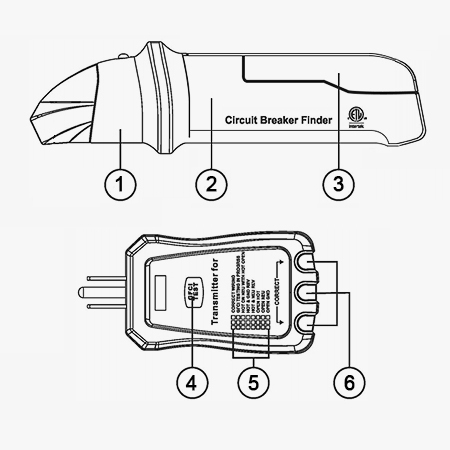The circuit breaker tool can meet various needs such as home, office, and factory power grid transformation. Equipped with a buzzer alarm and LED indicator, it is more convenient to use for on-site detection.

Fully Functional
- The breaker tester automatically detects and patrols the line to find the fault point in the circuit.
- Flexibly adjust the detector sensitivity by rotating the switch. (Adjust the sensitivity of the receiver to the minimum and keep slowly turning it up during the measurement until it can be accurately located to the break.)
- Low battery reminder to maintain efficient detection.

Convenient Operation
- The breaker locator tool can be directly plugged into the socket for GFCI testing. (Please press the GFCI button before use to check whether it can return to its original position. If not, do not plug this device into the circuit and seek help from a professional electrical engineer.)
- Buzzer and 3 LED indicators, quickly read to judge the working status of the circuit.
Applications
The circuit breaker finder is suitable for a variety of scenarios, such as circuit maintenance in commercial buildings, shopping malls, and other places, power system fault troubleshooting on factory production lines, circuit maintenance in residential areas and residential buildings, and power system fault detection in public facilities such as street lights and traffic lights.

Residential Area

Commercial Building

Production Line

Facilities
| Model | SISCO-CBF-UT25A |
| Operating Voltage | AC 90~120V |
| Operating Frequency | 47~63Hz |
| GFCI Test | About 6mA |
| Power Supply | 9V battery (6F22) |
| Transmitter Dimension | 103mm×56mm×30mm |
| Receiver Dimension | 192mm×54mm×28mm |
| Packing Dimension | 290mm×170mm×55mm |
| Weight | 450g |
Structure Diagram

- LED Indicator Light with LlineTtracking.
- ON/OFF Switch
- 9VDC
- GFCl Test Button
- Indicator Light Description
- LED Status Indicator
Q1: How does the Circuit Breaker Finder work?
A1: The working principle of a circuit breaker locator is based on the principle of current detection and electromagnetic induction. A circuit breaker finder usually installs a sensor in the circuit to detect the change of current in real time. When the current in the circuit reaches or exceeds the rated current of the circuit breaker, the circuit breaker will automatically trip and cut off the circuit. At this time, the circuit breaker detector will detect the change of current, and then generate an instantaneous voltage signal through the principle of electromagnetic induction, which can be sensed by the detector. The circuit breaker detector usually converts the detected signal into a digital signal and analyzes and processes it through a computer or other equipment. In this way, real-time monitoring and control of the circuit operation status can be achieved. Through the circuit breaker detector, faults and problems in the circuit can be discovered in time, and corresponding measures can be taken to repair them to ensure the safe operation of the circuit.
Q2: What are the main functions of Circuit Breaker Finder?
A2: The main functions of the circuit breaker finder include, but are not limited to:
Fault location: In complex electrical layouts, it may be difficult to manually find a specific circuit breaker. The circuit breaker finder can accurately find the location of the circuit breaker in the circuit.
Fault diagnosis: Easy to operate, usually only requires the probe of the circuit breaker finder to be connected to the socket or switch of the circuit, and then the device will indicate which circuit breaker controls the circuit, and will use a variety of signals such as sound, light or vibration to indicate, so as to quickly analyze the cause of the fault.
Quick response: When a circuit fails, it can respond quickly to cut off the faulty circuit and prevent the problem from expanding.
Easy to operate: The design is user-friendly and easy to operate. Even non-professionals can quickly get started. There is no need to physically contact the circuit or circuit breaker. Non-invasive detection is usually suitable for many types of electrical panels and circuit breakers.
Q3: What are the advantages of a circuit breaker finder?
A3: The advantages of an electric breaker finder tool are improved efficiency, Reduced costs, Enhanced safety, and ease of management. Greatly shorten the troubleshooting time and improve work efficiency. Reducing economic losses caused by power outages. Avoid safety hazards caused by manual fault finding. Facilitating daily management and maintenance of the power system.
Tips: Operation Steps of Circuit Breaker Finder
The steps of operating the circuit breaker finder usually include connecting the device, powering the self-test, starting detection, fault location, and fault repair.
- Connecting the finder to the circuit to ensure the correct connection.
- Turn on the device and perform a self-test to ensure normal operation of the device.
- According to the device instructions, start detecting the circuit breaker position in the circuit. According to the feedback from the device, determine the exact location of the fault point.
- After finding the fault point, take corresponding measures to repair it.
Thank you for buying industrial test and measurement equipment on SISCO.com, all products sold by SISCO and the partner cover a 12 months warranty, effective from the date of receiving the products.
What is covered?
SISCO is responsible for providing free spare parts, and free technical support to assist the customer to repair the defective products until the problem is solved.
What is not covered?
- Product purchased from anyone other than a SISCO store or a SISCO authorized reseller.
- Expendable parts.
- Routine cleaning or normal cosmetic and mechanical wear.
- Damage from misuse, abuse or neglect.
- Damage from use of parts other than SISCO approved.
- Damage from use outside the product’s usage or storage parameters.
- Damage from use of parts not sold by SISCO.
- Damage from modification or incorporation into other products.
- Damage from repair or replacement of warranted parts by a service provider other than a SISCO authorized service provider.
- Damage caused by the application environment not meeting the product usage requirements and the failure to perform preventive maintenance.

